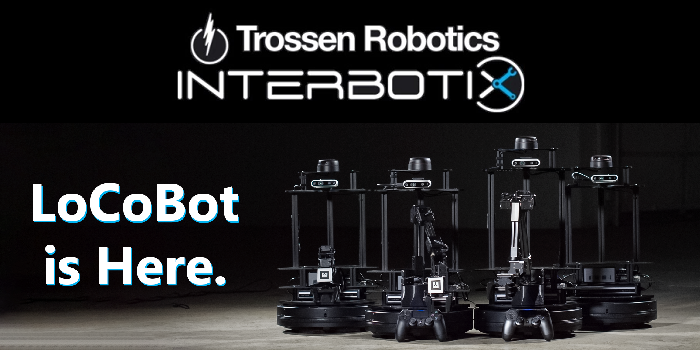Partner Spotlight: Trossen's New LoCoBot
4th May 2021
The LoCoBot™ is an ROS research rover for mapping, navigation and manipulation (optional) that enables researchers, educators and students alike to focus on high level code development instead of hardware and building out lower level code. Development on the LoCoBot is simplified with open source software, full ROS-mapping and navigation packages and modular open source Python API that allows users to move the platform as well as manipulator in as few as 10 lines of code.
The rover is built on the Yujin Robot Kobuki Base (YMR-K01-W1) and powered by the Intel NUC NUC8i3BEH Core i3 w/ 8gig of ram and 240g HD. An Intel® RealSense™ Depth Camera D435 sits atop an independently controlled pan / tilt mechanism (2XL430-W250-T) at the top of the platform which allows mapping and scanning. The (optional) 360 degree LIDAR can further improve both mapping and scanning for more advanced projects.
There are 3 different robot arms that can be added to the LoCoBot platform, offering 4, 5 and 6 degree of freedom options. All of the arms feature the X-Series servos from Robotis Co., specifically the XM430-W350-T and XL430-W250- which offer easy hardware setup, available software API’s and other ‘smart servo’ benefits.
While other servos require a direct connection to a microcontroller, DYNAMIXELs are daisy-chainable, only requiring a single servo to connect with the U2D2 driver board. This makes cable management a breeze and gives a sleeker look to robots built with them. Similarly, the U2D2 itself has a very small footprint, but is capable of communicating at the high baud-rates (1 Mbps or more) needed to perform real-time control without packet loss.
From a software standpoint, these servos already come with open source driver code in the form of the DYNAMIXEL Workbench Toolbox. This API abstracts away low level registers and serial communication protocols, making it easy to program higher level code that can work with any Protocol 2.0 DYNAMIXEL servo - not just the three used in the new platforms. Similarly, the E-Manual provides extensive documentation - both on getting started with the API and on understanding the purpose of all the available registers. The DYNAMIXEL Wizard 2.0 tool also makes it easy to get familiar with the registers and debug issues that may arise.
Lastly, the ‘smart servo’ capabilities of the DYNAMIXEL products were very helpful. For example, the ‘Time-Based Profile’ Drive Mode register in conjunction with the ‘Profile Velocity’ and ‘Profile Acceleration’ registers made it very simple to get all the motors to perform smooth motion for a given duration of time. Similarly, the ability to set ‘Secondary IDs’ and put motors in ‘Reverse’ mode made it easy to work with dual-motor joints (WX200 and WX250S models). This is besides the fact that users have the ability to torque on/off motors at will (to pose the arm or camera for example), work in different operating modes (position for the arm joints or PWM for the gripper), or get ‘Present Position’ feedback data to always know the state of the robot.
At the end of the day, the DYNAMIXEL servos were a key element in developing the Interbotix LoCoBot platforms. Their modular design, well-documented software, and customizability was an integral part in creating the world’s next-gen robotic research rover!
The new LoCoBots can be purchased directly from Trossen Robotics.
Take a look at the LoCoBot in 3D!



